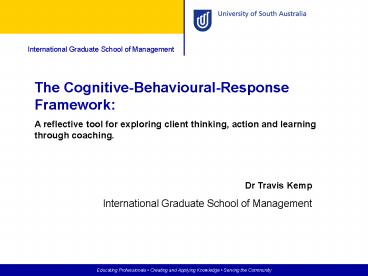Dr Travis Kemp - PowerPoint PPT Presentation
1 / 22
Title:
Dr Travis Kemp
Description:
... what can be termed existential dissonance when they become aware of having ... Establish awareness of cognitive-behavioural dissonance ... – PowerPoint PPT presentation
Number of Views:76
Avg rating:3.0/5.0
Title: Dr Travis Kemp
1
The Cognitive-Behavioural-Response Framework A
reflective tool for exploring client thinking,
action and learning through coaching.
Dr Travis Kemp International Graduate School of
Management
2
Introductions
- Welcome Introductions
- Objectives of the session
- Working through the modelan experiential
adventure - A case study application example
- Some helpful hints
- Any special requests?
3
Objectives of the Session
Present An exploratory experiential Coaching
intervention designed to achieve
cognitive-perceptual re-framing Share The model
through direct experience of it Discuss A case
study example of how the framework has been
applied Apply When could this style of
intervention be utilised and by whom? Create
Insights and opportunities for further
development, application and empirical
investigation of the effectiveness of the model
4
Foundations of the Model
- Existentialist Theory (Jean-Paul Sartre,1971)
- People are responsible for their own lives, for
their own actions and for their failures to take
action - People experience what can be termed existential
dissonance when they become aware of having
avoided either a commitment or making a choice - Inauthentic existence is reflected by individuals
who lack an awareness of personal responsibility
for their lives and passively assume that their
existence is controlled by external forces.
5
Foundations of the Model
- Reality Therapy (Glasser, 1965)
- Emphasis on cognitive and behavioural choice
theory - Responsibility clients own their behavioural
choices - Present focused We are products of the past but
we cant change it - WDEP Wants and needs, Direction doing,
Evaluation, Planning Commitment (Glasser
Wubbolding, 1995)
6
Foundations of the Model
Cognitive-Behaviour Modification (Michenbaum,
1977) Phase 1 Self-observation Phase 2
Starting a new internal dialogue Phase 3
Learning new skills
7
Foundations of the Model
- Positive Psychology (Seligman, 2002)
- Optimal human functioning
- Personal Mastery
- Authenticity
- Identification and development of strengths
8
Proactivityan emergent construct
measure of a personal disposition toward
proactive behaviour is intended to identify
differences among people in the extent to which
they take action to influence their
environmentsproactive personalities identify
opportunities and act on them they show
initiative, take action, and persevere(Crant,
1995, p532).
9
Proactivity explored
Significant Pearson Correlations (Plt.05) between
Proactive Personality and Locus of
Control Global Self Esteem General Self
Efficacy (Kemp, 2001) Sound
criterion and discriminant validity (Crant,
1995) Sound Internal validity (Bateman
Crant, 1993)
10
Aims of the Model
- Free a client who is experiencing stuckness
- Stimulate proactive behaviour
- Explore multiple response options
- Acceptance of controllable and uncontrollable
factors - Ownership of personal responsibility for action
- Establish awareness of cognitive-behavioural
dissonance
11
Experiencing the Model
- Find a partnera short risk taking exercise
- Introduce yourself to your partner and share
these 3 things - Your name
- Where youre from and what you do professionally
- Something you have done which you hope your
Mother will never find out about.
12
(No Transcript)
13
(No Transcript)
14
(No Transcript)
15
(No Transcript)
16
Critical Coach Behaviours
Relationship is central to Coaching
effectiveness A shared journey or
Adventure Concern and Empathy for the
client Modeling authentic behaviour Acknowledgin
g Fear Courageous Action and Behaviour Presence
and intimacy in the relationship
17
Critical Coach Behaviours
Ownership of responsibility Coach and
client Encouragement and support Positive
information based feedback Once the past has been
identified, maintain operation in the
present Warm confrontation Transparency in
relation to the process of development
18
Meet Belinda Mitchell
CEO of not-for-profit advocacy organisation Promot
ed from the ranks Ex-practitioner Strongly
values driven Us versus Them mindset The
clients and their carers must be protected
19
Meet Belinda Mitchell(not her real name)
Passionate, committed and righteous Still has a
vested personal interest in maintaining her
contribution as a practitioner Goal is to
transform the organisation and raise its
public profile to draw attention to the valuable
contribution the organisation makes Is struggling
to let go of doing and embrace leading
20
Where else can the model be used?
Group coaching to move past a cultural
legacy In supervision to explore ones own
stuckness with a client or clients As a
register for accomplishment for clients
progress As a quick dirty check-inWhere
are you on the continuum today?
21
Where to from here?
Further validation and case studies utilising
pre-post test measures of Proactive Personality
(See the Proactive Personality
Scale) Measurement of personality constructs
such as Locus of Control, Self Esteem and General
Self Efficacy as determinant variables in the
coaching relationship to ascertain any mediating
effects on coaching outcomes Others?
22
Questions
travis.kemp_at_unisa.edu.au

